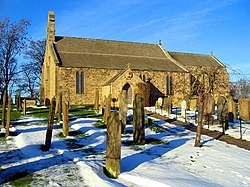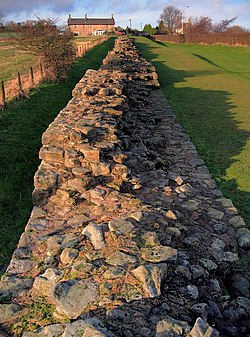Heddon-on-the-Wall
| Heddon-on-the-Wall | |
| Northumberland | |
|---|---|
 St Andrew's Church, Heddon-on-the-Wall | |
| Location | |
| Grid reference: | NZ135665 |
| Location: | 54°59’35"N, 1°47’28"W |
| Data | |
| Population: | 1,563 (2011) |
| Post town: | Newcastle Upon Tyne |
| Postcode: | NE15 |
| Dialling code: | 01661 |
| Local Government | |
| Council: | Northumberland |
| Parliamentary constituency: |
Hexham |
Heddon-on-the-Wall is a village just outside Throckley, in Northumberland, and about nine miles west of the centre of Newcastle upon Tyne, Northumberland's great city. The village is on Hadrian's Wall, which gives it its suffix. The name 'Heddon' is form the Old English hæþ dun, meaning 'heath hill' or 'heather hill'. Heddon-on-the-Wall has two public houses, The Three Tuns and The Swan Inn.
History
A Roman milecastle ('Milecastle 12') was located at the site of the present-day village, under what is now Town Farm, but no traces of it are currently visible.
Prior to the 1960s, Heddon-on-the-Wall was a small village with an economy based strongly on traditional industry including farming and coal mining.
Large-scale coal mining close to the village began in the late 1950s with the opening of the Bays Leap, a 300 acres opencast mine site located a short distance north of Heddon-on-the-Wall. The site supported seven coal seams at its peak, and evidence was found of earlier mine shafts. Bays Leap closed in 1966. Urban development west of Newcastle saw the village expand substantially during the 1960s.[1]
Heddon-on-the-Wall grew up around Hexham Road, which until 1973 was the main road from Newcastle to Hexham.[2] The new A69 road bypasses Heddon-on-the-Wall en route from Newcastle to Carlisle, also passing Hexham. Heddon-on-the-Wall benefits from its proximity to the A69 but is more popular with retired people rather than commuters due to its lack of a railway station, from which its close neighbour Wylam benefits. A railway station on the Scotswood, Newburn & Wylam Railway was opened in the village in 1881, but closed in 1958.[3]
Heddon-on-the-Wall came to prominence when it was revealed in February 2001 that the 2001 outbreak of Foot-and-mouth disease originated from a farm in the village.[4] This severely affected Heddon-on-the-Wall's primary industry which is agriculture.
Over the years however other industries have existed in Heddon-on-the-Wall. These include salmon fishing in the River Tyne, coal mining, the quarrying of sandstone and limestone, and brick making.[5] A number of blacksmiths were in the village until recent times. In the seventies there was a perfumery manufacturing business and recently a brewery.
Society and culture
Heddon-on-the-Wall attracts tourists passing through on tours of Hadrian’s Wall. Heddon-on-the-Wall is located on the Hadrian's Wall Path, and contains the longest section of unbroken wall at its original and planned width, now known as Broad Wall. Later sections were not built to the full width to save time and money.
St Andrew's Church is located opposite the Swan Inn and parts of it are Anglo-Saxon dating back to 680 AD. It was originally consecrated in 630AD.[5] The oldest parts of St Andrew's are still visible in some of the walls of the chancel behind the choir stalls. The original stone structure was built using recycled stone from Hadrian’s Wall.
There is a cycle route up to Heddon on the Wall from the National Cycle Route running along the river. There is a route through a farmyard about 1a quarter of a mile west of Blayney Row, though hindered by stiles and gates and the farmyard, not to mention the gruelling straight climb up the side of the Tyne Valley to Heddon, though the vigorous cyclist is rewarded eith beautiful views approaching the top.
Outside links
| ("Wikimedia Commons" has material about Heddon-on-the-Wall) |
References
- ↑ "Walking around Hadrian’s Wall: Heddon-on-the-Wall". National Trails. http://www.nationaltrail.co.uk/HadriansWall/uploads/Heddon%20on%20the%20wall.pdf. Retrieved 22 November 2011.
- ↑ "Castle Morpeth District Local Plan 1991 - 2006". 19 February 2004. Index: Chapter 8 - Roads and Transportation. http://www.cmlocalplan.co.uk/aspcode/gettext.asp?chapter=8. Retrieved 25 June 2012.
- ↑ Young, Alan. "Disused stations: Heddon-on-the-Wall". disused-stations.org.uk. http://www.disused-stations.org.uk/h/heddon_on_the_wall/index.shtml. Retrieved 10 August 2011.
- ↑ "Foot and mouth: Tracing the epidemic". The Guardian. http://www.guardian.co.uk/footandmouth/flash/0,7365,443772,00.html. Retrieved 8 September 2011.
- ↑ 5.0 5.1 "Heddon on the Wall Parish Council". http://www.parish-council.com/heddononthewall/. Retrieved 8 September 2011.

